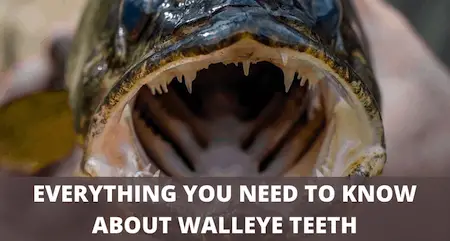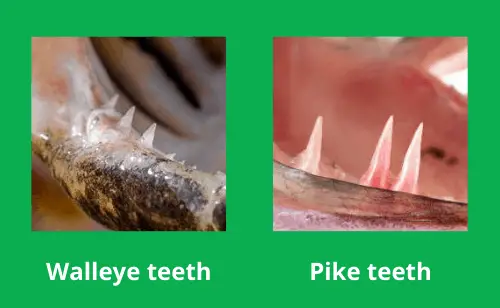Walleye Teeth Facts: Everything You Need To Know
UPDATED 03 NOVEMBER 2023
by Robert Ceran
If you’re new to angling and want to target walleye, you might be wondering whether they have teeth, and if they are sharp enough to pose a danger to your hands or to your fishing line.
Here’s the quick answer:
Yes, as carnivorous fish, walleye have rows of long canine teeth protruding from both the upper and lower jaws. These canines are used to grab and hold live prey fish when hunting.
However, unlike the razor sharp teeth of pike, those of walleye are more rounded at their tip, and pose less of a threat to humans, or to fishing line.

Walleye teeth facts
Similar to many other carnivorous fish, walleye have a set of long canines that are readily visible in the front part of their mouth. In fact, there is a prominent group of 4-8 long pointed teeth right at the front end of the mouth, where they are ideally positioned to grab and hold small prey fish (see photo above).
Similar to other vertebrates, walleye fish teeth have enamel and dentine parts. However, unlike mammals and humans, they are able to renew them continuously over their entire lifetime. In other words, walleye can shed them and regrow them again.
They do so continuously at a slow rate, and there’s no evidence that this shedding and renewal happens in a seasonal pattern.
See also: How to use a Lindy rig
In addition to their long canines, there are also sets of shorter ones between them, as well as even smaller ones inside the mouth cavity, and on the surface of the gill rakers.
All of these are intended to help the walleye hold on to struggling prey fish that have a slippery surface.
Walleye swallow their prey head first. So when they grab a live fish, they need to move it around until its head points down the gullet, and their teeth are designed to avoid the struggling prey escaping during this process.
Do walleye have sharp teeth?
Yes, walleye teeth are definitely sharp. But they are not razor sharp like those of pike, due to their more rounded tops. Take a look a the photo below, which compares the two side by side:
So while they are sharp, they aren’t as sharp as those of pike and muskie. This explains why walleye anglers very rarely get bitten, while it’s quite a common occurrence among pike anglers.

But when handling walleye, you still need to make sure to avoid putting your hand inside the mouth, and we’ll tell you how to do that correctly further down the page.
On a side note, the teeth of small walleye tend to be sharper than those of big ones, due to the fact that they are more narrow, and therefore have sharper tips.
So definitely make sure to avoid putting your fingers inside the mouth, and use a set of pliers to remove the hook.
Can walleye teeth cut line
Since walleye teeth tend to have more blunt points, they are unable to cut line. If you take another look at the photo above, you can see their rounded points, and because of this, you don’t need to use a metal leader when fishing for walleye.
In fact, using a metal leader would put you at a serious disadvantage, since walleye have good eyesight and often tend to be finicky biters.
So when trying to target walleye with jigging, it’s best to use a fluorocarbon leader, since this has very low visibility in the water.
However if you are fishing in a lake where there’s a good chance of catching pike or muskie as well, you might want to use a stronger leader, since pike can readily cut fishing line.
This is also true if you’re trolling for walleye in waters with strong populations of northern pike or muskie.
Can walleye bite you?
While there’s no report of walleye attacking humans intentionally, you can definitely get bitten by a walleye if you put your hand inside their mouth. This has actually happened to a couple of anglers I know personally.
It may be necessary to get inside the mouth of the fish in order to remove your hook. This is more of an issue if you’re using live bait, since the fish can end up swallowing the bait before you set the hook, which makes it harder to remove afterwards.
In order to avoid walleye bite during hook removal, make sure you have a good set of fishing pliers that are long enough to reach all the way to the back of a big walleye mouth. In some cases, you may also be able to reach the hook through the gill slits, which can help you to avoid the front part of the mouth.
If you do get bitten, it’s essential to clean and disinfect the wound as fast as possible, since it may get infected with bacteria living inside the walleye’s mouth. In some cases of pike bites that I know about, the anglers hat to get antibiotic shots in order to get rid of the infection.
How to hold a walleye
If you want to avoid being bitten, you have to know where to hold walleye when you pull them out of the water. With small ones, you can grab them behind the head, with your thumb and finders straddling their back just in front of the spiny dorsal fin.
If a fish is too big for this option, the best way to grab it is by inserting your fingers underneath the bottom of the gill cover, and sliding them forward until you reach the V-shaped part at the front, so you can pull them up out of the water. And by putting your fingers underneath the gill cover, you avoid being bitten.
Once you’ve got the whole fish out of the water, then use the other hand to support the belly of the fish as well. This is also a great way to hold it up to pose for a photo. Since most anglers practice catch and release, it’s important to know how to grab a walleye without damaging it.
When grabbing the fish underneath the gill cover, make sure you don’t insert your fingers all the way into the red part of the gills, which is very sensitive and should never be touched if you want to release them alive.
If you want to avoid using your hands completely to land fish, you can also use a landing net, or lip grippers. Keep in mind that a net needs to be big enough to handle fish that are up to 30 inches long.
And while a net can damage the slime layer on top of the fish skin, a lip gripper (which is similar to a set of pliers) only handles the bony part of the jaw, and so does very little damage to the fish.
Conclusion
In summary: while you should make sure to avoid putting your hand inside the mouth of a walleye, they are not vicious fish, and there’s no need to fear them.
In fact millions of anglers enjoy catching walleye every year without any problems at all, and I recommend you try it out for yourself.
